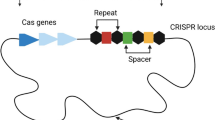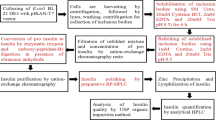Abstract
New Delhi metallo-beta-lactamase (NDM-1) is a plasmid-borne enzyme conferring bacterial resistance to any known beta-lactam antibiotics. There is urgent need to develop efficient NDM-1 inhibitors and approaches for early diagnostics of NDM-1 that necessitates structural studies of the enzyme and analysis of the secretion pathways and localization of the protein. Recombinant full-length NDM-1 is produced in E. coli in active form and mostly accumulates in inclusion bodies. We developed a new system that uses antibiotic pressure to select E. coli producing increased quantities of the soluble NDM-1 and showed that the efficiency of production of the soluble NDM-1 depends on the level of chaperone activity in a bacterial cell.
Similar content being viewed by others
References
Kolesnikov, A.V., Zakharova, M.Yu., Kozyr, A.V., and Shemyakin, I.G., RF Patent no. 2361921, 2009.
Amrein, K.E., Takacs, B., Stieger, M., et al., Proc. Natl. Acad. Sci. U.S.A., 1995, vol. 92, pp. 1048–1052.
Bebrone, C., Biochem. Pharmacol., 2007, vol. 74, pp. 1686–1701.
Bochkareva, E.S., Lissin, N.M., and Girshovich, A.S., Nature, 1988, vol. 336, pp. 254–257.
Bush, K. and Jacoby, G., Antimicrob. Agents Chemother., 2010, vol. 54, pp. 969–976.
Carfi, A., Pares, S., Duée, E., et al., EMBO J., 1995, vol. 14, pp. 4914–4921.
Caspers, P., Stieger, M., and Burn, P., Cell Mol. Biol., 1994, vol. 40, pp. 635–644.
Drawz, S.M. and Bonomo, R., Clin. Microbiol. Rev., 2010, vol. 23, pp. 160–201.
Druker, B.J., Tamura, S., Buchdunger, E., et al., Nat. Med., 1996, vol. 2, pp. 561–566.
Feldman, C. and Anderson, R., Drugs, 2011, vol. 71, pp. 131–153.
García-Saez, I., Hopkins, J., Papamicael, C., et al., J. Biol. Chem., 2003, vol. 278, pp. 23868–23873.
Gillespie, S.H. and Singh, K., Recent Pat. Antiinfect. Drug Discov., 2011, vol. 6, pp. 77–83.
Guo, Y., Wang, J., Niu, G., et al., Protein Cell, 2011, vol. 2, pp. 384–394.
Hanes, C.S., Biochem. J., 1932, vol. 26, pp. 1406–1421.
Helfand, M.S. and Bonomo, R.A., Curr. Drug Targets Infect. Disord., 2003, vol. 3, pp. 9–23.
Ho, P.L., Lo, W.U., Yeung, M.K., et al., PLoS One, 2011, vol. 9, p. e17989.
Jin, W., Arakawa, Y., Yasuzawa, H., et al., Biol. Pharm. Bull., 2004, vol. 27, pp. 851–856.
Khlebnikov, A., Datsenko, K.A., Skaug, T., et al., Microbiology, 2001, vol. 147, pp. 3241–3247.
Khlebnikov, A., Risa, O., and Skaug, T., J. Bacteriol., 2000, vol. 182, pp. 7029–7034.
Kim, Y.C., Tesar, C., Mire, J., et al., PLoS One, 2011, vol. 6, p. e24621.
King, D. and Strynadka, N., Protein Sci., 2011, vol. 20, pp. 1484–1491.
Kumarasamy, K.K., Toleman, M.A., Walsh, T.R., et al., Lancet Infect. Dis., 2010, vol. 10, pp. 597–602.
Llarrull, L.I., Testero, S., Fisher, J.F., et al., Curr. Opin. Microbiol., 2010, vol. 13, pp. 551–557.
Marra, A., Fut. Microbiol., 2011, vol. 6, pp. 137–141.
Walker, J.E., J. Mol. Biol., 1996, vol. 260, pp. 289–298.
Nathwani, D., Davey, P.G., and Marwick, C.A., Clin. Evid., 2010. http://www.ncbi.nlm.nih.gov/pubmed?term=PMID%3A%2021418679. Accessed September 19, 2012.
Predonzani, A., Arnoldi, F., and Lopez-Requena, A., BMC Biotechnol., 2008, vol. 8, p. 41.
Rasmussen, B.A., Yang, Y., Jacobus, N., et al., Antimicrob. Agents Chemother., 1994, vol. 38, pp. 2116–2120.
Siemann, S., Clarke, A.J., Viswanatha, T., et al., Biochemistry, 2003, vol. 42, pp. 1673–1683.
Sun, G. and Budde, R.J., Protein Expr. Purif., 2001, vol. 21, pp. 8–12.
Tamilselvi, A. and Mugesh, G., J. Biol. Inorg. Chem., 2008, vol. 13, pp. 1039–1053.
Thomas, P.W., Zheng, M., Wu, S., et al., Biochemistry, 2011, vol. 50, pp. 10102–10113.
Tyler, B., Loomis, W.F., Jr., Magasanik, B., et al., J. Bacteriol., 1967, vol. 94, pp. 2001–2011.
Vanhove, M., Zakhem, M., Devreese, B., et al., Cell. Mol. Life Sci., 2003, vol. 60, pp. 2501–2509.
Wanger, S., Klepsch, M.M., Schlegel, S., et al., Proc. Natl. Acad. Sci. U.S.A., 2008, vol. 105, pp. 14371–14376.
Yamamoto, T., Takano, T., Iwao, Y., et al., J. Infect. Chemother., 2011, vol. 17, pp. 435–439.
Yang, H., Aitha, M., Hetrick, A.M., et al., Biochemistry, 2012, vol. 51, pp. 3839–3837.
Yong, D., Toleman, A.M., Giske, G.C., et al., Antimicrob. Agents Chemother., 2009, vol. 53, pp. 5046–5054.
Zhang, H. and Hao, Q., FASEB J., 2011, vol. 25, pp. 2574–2582.
Author information
Authors and Affiliations
Corresponding author
Additional information
Original Russian Text © A.V. Kozyr, N.M. Luneva, A.E. Khlyntseva, I.G. Shemyakin, O.N. Krasavtseva, A.V. Kolesnikov, 2013, published in Molekulyarnaya Genetika, Mikrobiologiya i Virusologiya, 2013, No. 4, pp. 15–21.
About this article
Cite this article
Kozyr, A.V., Luneva, N.M., Khlyntseva, A.E. et al. Antibiotic-dependent selection of E. coli clones with increased chaperone activity for highly efficient production of full-length soluble new delhi metallo-beta-lactamase. Mol. Genet. Microbiol. Virol. 28, 147–155 (2013). https://doi.org/10.3103/S0891416813040046
Received:
Published:
Issue Date:
DOI: https://doi.org/10.3103/S0891416813040046




